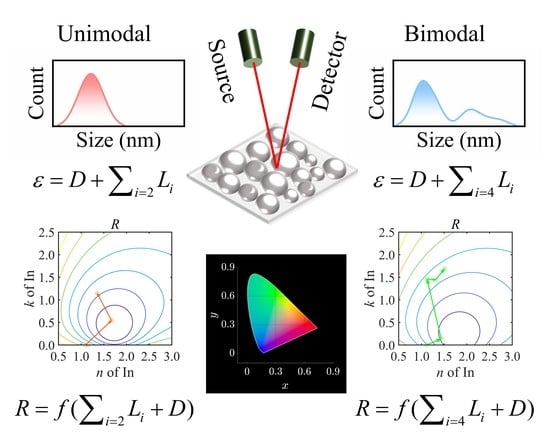Interpretation of Reflection and Colorimetry Characteristics of Indium-Particle Films by Means of Ellipsometric Modeling
Abstract
1. Introduction
2. Materials and Methods
3. Results and Discussion
3.1. Effective Structure with a Single Interface
3.2. Effects of n, k of Indium Films on the Reflectance Spectra
3.2.1. Oscillator Decomposition for the Particulate Indium with a Unimodal Distribution
3.2.2. Oscillator Decomposition for the Particulate Indium with a Bimodal Distribution
3.2.3. Oscillator Decomposition for the Particulate Indium without Reflectance Knee Point
3.3. Evolutions of the Colorimetric Parameters
4. Conclusions
Supplementary Materials
Author Contributions
Funding
Data Availability Statement
Acknowledgments
Conflicts of Interest
References
- Koyama, R.Y.; Smith, N.V.; Spicer, W.E. Optical properties of indium. Phys. Rev. B 1973, 8, 2426–2432. [Google Scholar] [CrossRef]
- Mathewson, A.G.; Myers, H.P. The optical absorption of indium. J. Phys. C Solid State Phys. 1972, 5, 2503–2510. [Google Scholar] [CrossRef]
- Lemonnier, J.C.; Jezequel, G.; Thomas, J. Optical properties in the far UV and electronic structure of indium films. J. Phys. C Solid State Phys. 1975, 8, 2812–2818. [Google Scholar] [CrossRef]
- Gordillo, N.; Catalán-Gómez, S.; Pau, J.L.; Redondo-Cubero, A. Spectrally broad plasmonic absorption in Ga and In nanoparticle hybrids. Nanotechnology 2019, 30, 475705. [Google Scholar] [CrossRef]
- Li, H.; Liang, C.; Liu, M.; Zhong, K.; Tong, Y.; Liu, P.; Hope, G.A. Synthesis of indium nanowires by Galvanic displacement and their optical properties. Nanoscale Res. Lett. 2009, 4, 47–53. [Google Scholar] [CrossRef]
- Wu, P.C.; Losurdo, M.; Kim, T.H.; Choi, S.; Bruno, G.; Brown, A.S. In situ spectroscopic ellipsometry to monitor surface plasmon resonant group-III metals deposited by molecular beam epitaxy. J. Vac. Sci. Technol. B 2007, 25, 1019–1023. [Google Scholar] [CrossRef]
- Moreira, C.; Wang, Y.; Blair, S.; Chadwick, E.; Lee, J.-Y.; Oliveira, L.; Lima, A.; Cruz, R. Approaches for deep-ultraviolet surface plasmon resonance sensors. Opt. Lett. 2020, 45, 4642–4645. [Google Scholar] [CrossRef]
- Jennings, C.; Aroca, R.; Hor, A.-M.; Loutfy, R.O. Surface-enhanced Raman scattering from copper and zinc phthalocyanine complexes by silver and indium island films. Anal. Chem. 1984, 56, 2033–2035. [Google Scholar] [CrossRef]
- Kumamoto, Y.; Taguchi, A.; Honda, M.; Watanabe, K.; Saito, Y.; Kawata, S. Indium for deep-ultraviolet surface-enhanced resonance Raman scattering. ACS Photonics 2014, 1, 598–603. [Google Scholar] [CrossRef]
- Das, R.; Soni, R.K. Synthesis and surface-enhanced Raman scattering of indium nanotriangles and nanowires. RSC Adv. 2017, 7, 32255–32263. [Google Scholar] [CrossRef]
- Dragan, A.I.; Geddes, C.D. Indium nanodeposits: A substrate for metal-enhanced fluorescence in the ultraviolet spectral region. J. Appl. Phys. 2010, 108, 094701. [Google Scholar] [CrossRef]
- Ho, W.-J.; Yang, H.-Y.; Liu, J.-J.; Lin, P.-J.; Ho, C.-H. Plasmonic effects of two-dimensional indium-nanoparticles embedded within SiO2 anti-reflective coating on the performance of silicon solar cells. Appl. Surf. Sci. 2020, 508, 145275. [Google Scholar] [CrossRef]
- Ho, W.-J.; Liu, J.-J.; Yang, Y.-C.; Ho, C.-H. Enhancing output power of textured silicon solar cells by embedding indium plasmonic nanoparticles in layers within antireflective coating. Nanomaterials 2018, 8, 1003. [Google Scholar] [CrossRef]
- Kristensen, A.; Yang, J.K.W.; Bozhevolnyi, S.I.; Link, S.; Nordlander, P.; Halas, N.J.; Mortensen, N.A. Plasmonic colour generation. Nat. Rev. Mater. 2016, 2, 16088. [Google Scholar] [CrossRef]
- Peng, J.; Jeong, H.H.; Lin, Q.; Cormier, S.; Liang, H.L.; De Volder, M.F.L.; Vignolini, S.; Baumberg, J.J. Scalable electrochromic nanopixels using plasmonics. Sci. Adv. 2019, 5, eaaw2205. [Google Scholar] [CrossRef] [PubMed]
- Chen, Y.-P.; Lai, C.-C.; Tsai, W.-S. Full-color based on bismuth core-shell nanoparticles in one-step fabrication. Opt. Express 2020, 28, 24511–24525. [Google Scholar] [CrossRef]
- Tan, S.J.; Zhang, L.; Zhu, D.; Goh, X.M.; Wang, Y.M.; Kumar, K.; Qiu, C.-W.; Yang, J.K.W. Plasmonic color palettes for photorealistic printing with aluminum nanostructures. Nano Lett. 2014, 14, 4023–4029. [Google Scholar] [CrossRef]
- Losurdo, M. Applications of ellipsometry in nanoscale science: Needs, status, achievements and future challenges. Thin Solid Films 2011, 519, 2575–2583. [Google Scholar] [CrossRef]
- Shan, Y.; Liu, P.; Chen, Y.; Zhang, H.; Tu, H.; Zheng, Y.; Zhang, R.; Wang, S.; Li, J.; Chen, L. Microstructure-induced anisotropic optical properties of YF3 columnar thin films prepared by glancing angle deposition. Nanomaterials 2020, 10, 2413. [Google Scholar] [CrossRef]
- Zhang, R.-J.; Chen, Y.-M.; Lu, W.-J.; Cai, Q.-Y.; Zheng, Y.-X.; Chen, L.-Y. Influence of nanocrystal size on dielectric functions of Si nanocrystals embedded in SiO2 matrix. Appl. Phys. Lett. 2009, 95, 161109. [Google Scholar] [CrossRef]
- Liu, S.; Chen, X.; Zhang, C. Development of a broadband Mueller matrix ellipsometer as a powerful tool for nanostructure metrology. Thin Solid Films 2015, 584, 176–185. [Google Scholar] [CrossRef]
- Little, S.A.; Collins, R.W.; Marsillac, S. Analysis of interband, intraband, and plasmon polariton transitions in silver nanoparticle films via in situ real-time spectroscopic ellipsometry. Appl. Phys. Lett. 2011, 98, 101910. [Google Scholar] [CrossRef]
- Yang, Y.; Akozbek, N.; Kim, T.H.; Sanz, J.M.; Moreno, F.; Losurdo, M.; Brown, A.S.; Everitt, H.O. Ultraviolet-visible plasmonic properties of gallium nanoparticles investigated by variable-angle spectroscopic and mueller matrix ellipsometry. ACS Photonics 2014, 1, 582–589. [Google Scholar] [CrossRef]
- Zhang, H.-T.; He, R.; Peng, L.; Yang, Y.-T.; Sun, X.-J.; Liu, B.-J.; Zhang, Y.-S.; Zheng, Y.-X.; Zhang, R.-J.; Wang, S.-Y.; et al. Structural origins of optical properties of nanosized indium particle films: An ellipsometric insight. Thin Solid Films 2023, 764, 139604. [Google Scholar] [CrossRef]
- Liu, P.; Shan, Y.; Chen, Y.; Zhang, H.; Han, C.; Yan, C.; Zheng, Y.; Zhang, R.; Wang, S.; Li, J.; et al. Characterization on percolation of nanostructured silver films by the topological properties of spectroscopic ellipsometric parameter trajectories. J. Phys. Chem. C 2020, 124, 28306–28312. [Google Scholar] [CrossRef]
- Schanda, J. CIE Colorimetry. In Colorimetry: Understanding the CIE System; Schanda, J., Ed.; John Wiley & Sons: Hoboken, NJ, USA, 2007; Volume 3, pp. 25–78. [Google Scholar]
- Johs, B.; Arwin, H.; Wagner, T.; Appel, D.; Peros, D. Accuracy of color determination from spectroscopic ellipsometry measurements. Thin Solid Films 2011, 519, 2711–2714. [Google Scholar] [CrossRef]
- Goossens, V.; Gotzen, N.; Gils, S.V.; Stijns, E.; Assche, G.V.; Finsy, R.; Terryn, H. Predicting reflections of thin coatings. Surf. Coat. Tech. 2009, 204, 551–557. [Google Scholar] [CrossRef]
- Macleod, H.A. Thin-Film Optical Filters, 5th ed.; CRC Press: Boca Raton, FL, USA, 2017; pp. 19–36. [Google Scholar]
- Abelès, F. La théorie générale des couches minces. J. Phys. Radium 1950, 11, 307–309. [Google Scholar] [CrossRef]
- Bohren, C.F.; Huffman, D.R. Absorption and Scattering of Light by Small Particles; John Wiley & Sons: New York, NY, USA, 1998; pp. 287–428. [Google Scholar]
- Hulst, H.C. Light Scattering by Small Particles; Dover Publications: New York, NY, USA, 1957; pp. 114–128. [Google Scholar]
- Meier, M.; Wokaun, A. Enhanced fields on large metal particles: Dynamic depolarization. Opt. Lett. 1983, 8, 581–583. [Google Scholar] [CrossRef]
- Born, M.; Wolf, E. Principles of Optics, 6th ed.; Pergamon Press: Oxford, UK, 1986; pp. 51–70. [Google Scholar]
- Jackson, J.D. Classical Electrodynamics, 3rd ed.; John Wiley & Sons: New York, NY, USA, 1999; pp. 309–316. [Google Scholar]
- Theye, M.L.; Devant, G. Optical properties of indium from thin film measurements. Thin Solid Film 1969, 4, 205–210. [Google Scholar] [CrossRef]
- Hetrick, R.E.; Lambe, J. Optical properties of small In particles in thin-film form. Phys. Rev. B 1975, 11, 1273–1278. [Google Scholar] [CrossRef]
- Aspnes, D.E.; Studna, A.A. Dielectric functions and optical parameters of Si, Ge, GaP, GaAs, GaSb, InP, InAs, and InSb from 1.5 to 6.0 eV. Phys. Rev. B 1983, 27, 985–1009. [Google Scholar] [CrossRef]
- Collins, R.W.; Ferlauto, A.S. Optical Physics of Materials. In Handbook of Ellipsometry; Tompkins, H.G., Irene, E.A., Eds.; William Andrew: New York, NY, USA, 2005; Volume 2, pp. 93–235. [Google Scholar]
- Levi, A.F.J. Essential Classical Mechanics for Device Physics; Morgan & Claypool Publishers: San Rafael, CA, USA, 2016; pp. 5-1–5-21. [Google Scholar]
- Lamb, H., XIII. On electrical motions in a spherical conductor. Philos. Trans. R. Soc. London 1883, 174, 519–549. [Google Scholar]
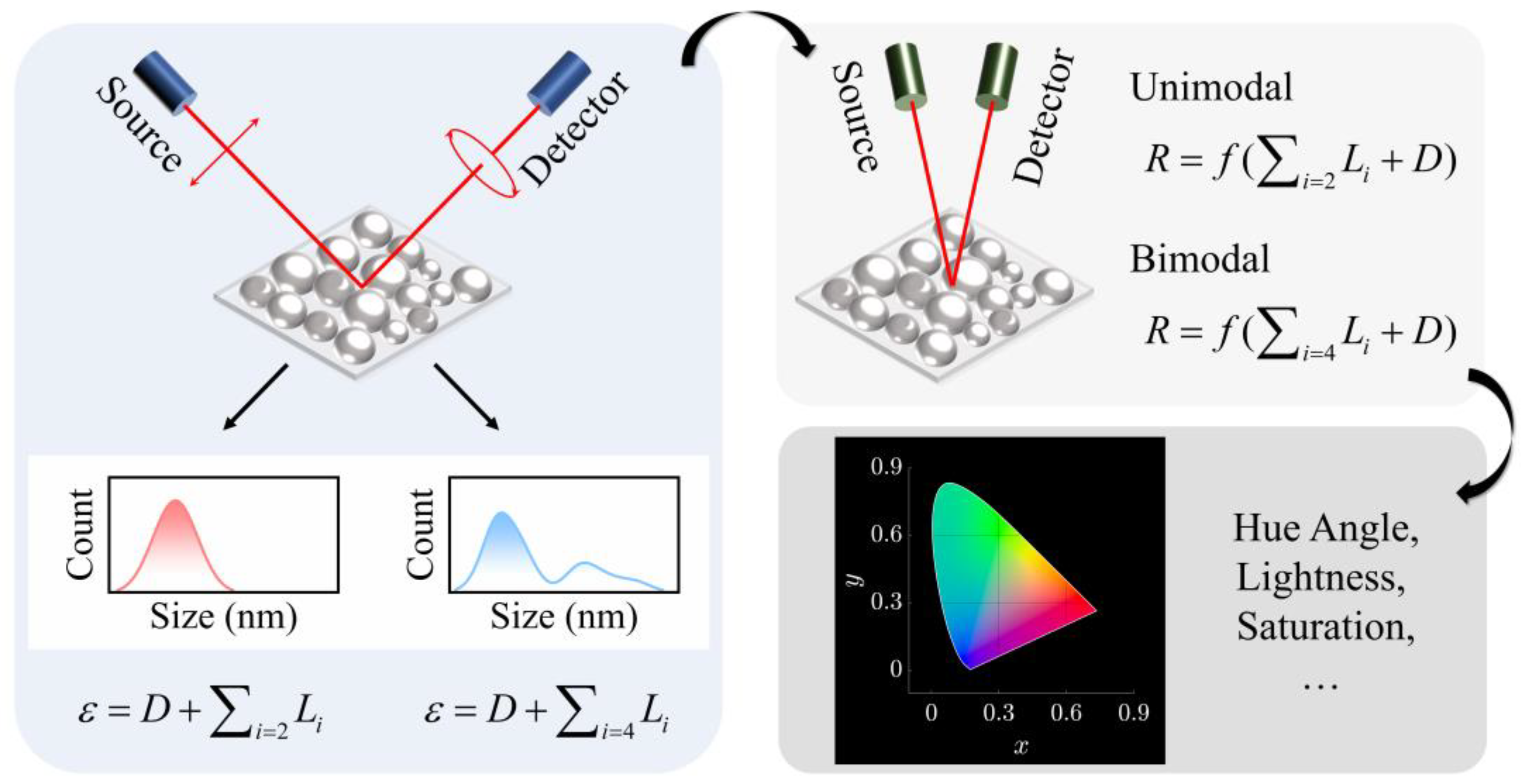
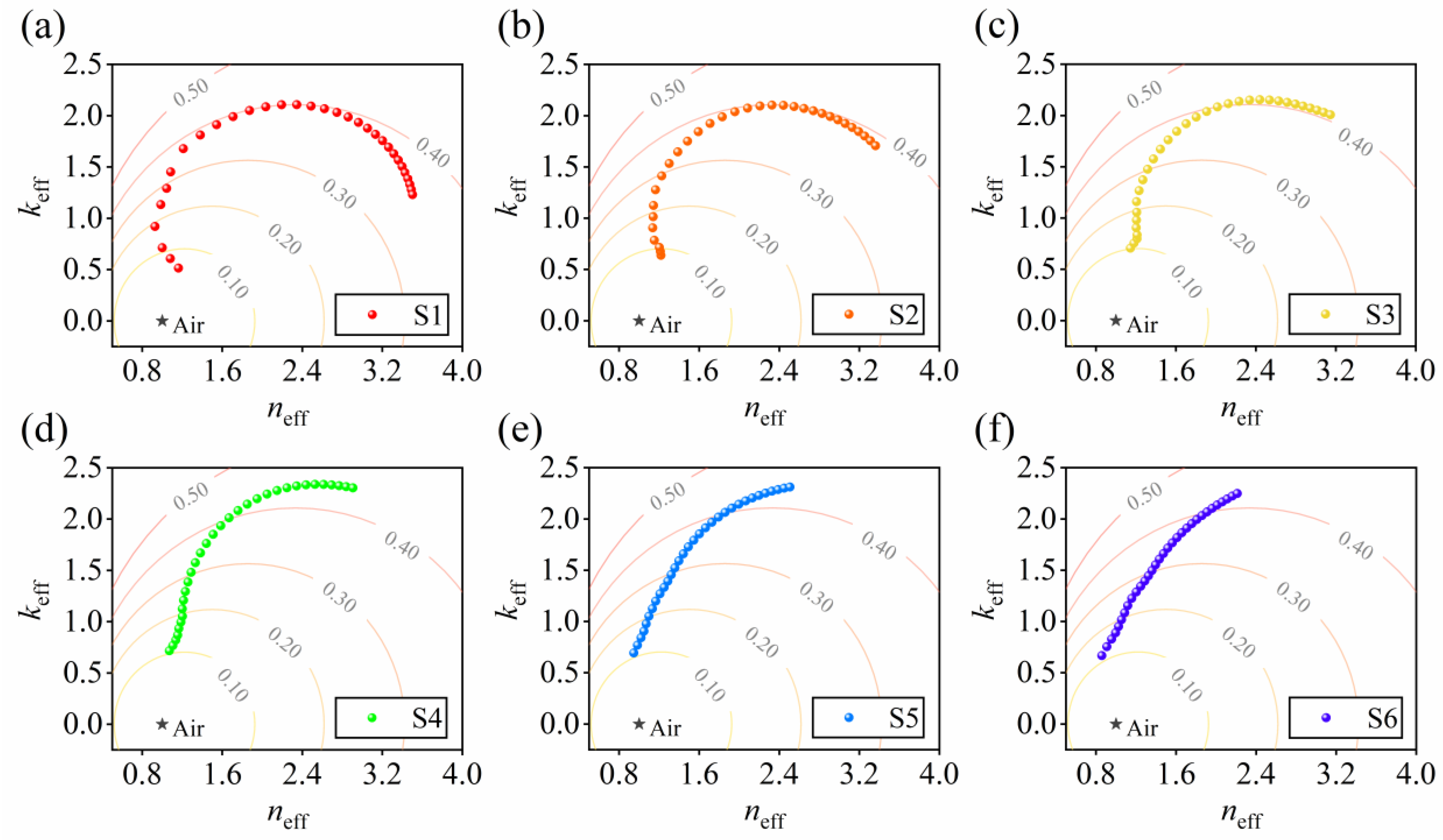
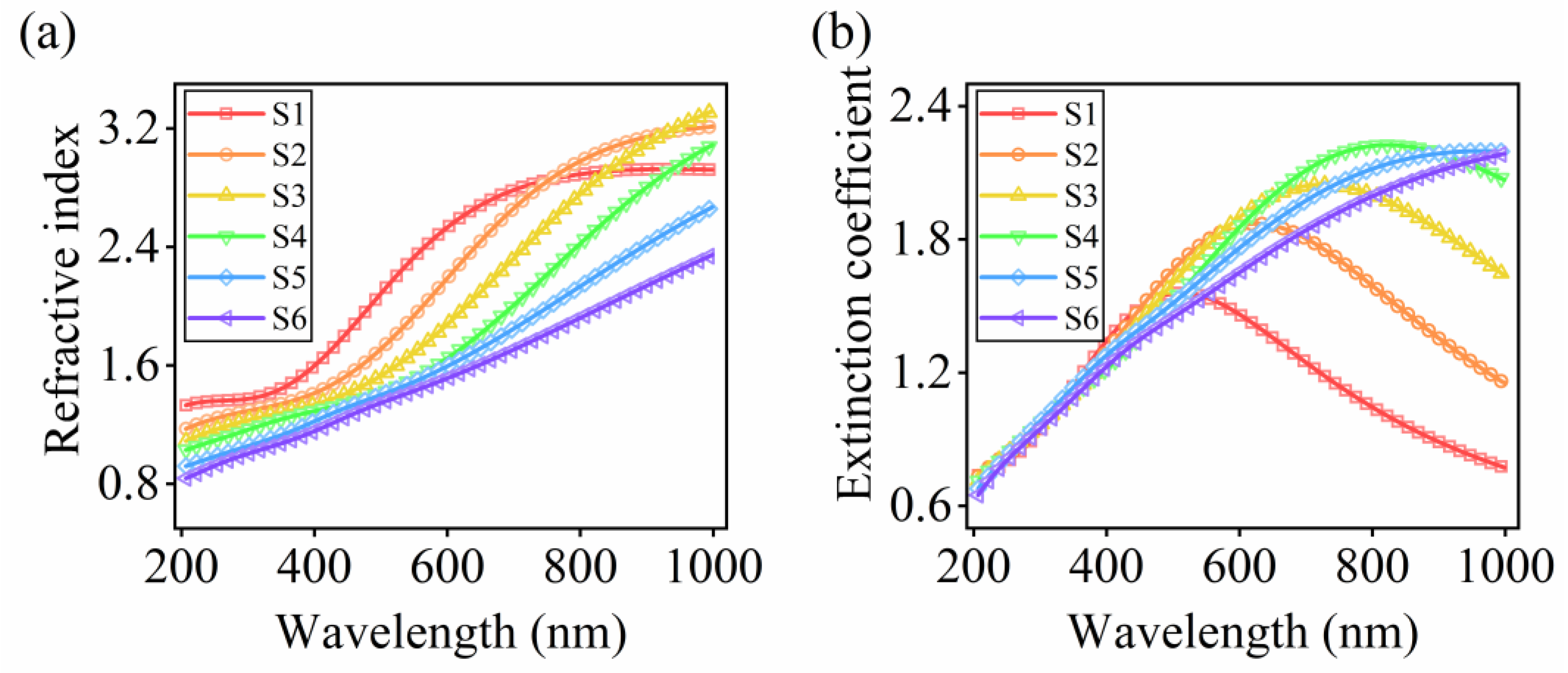
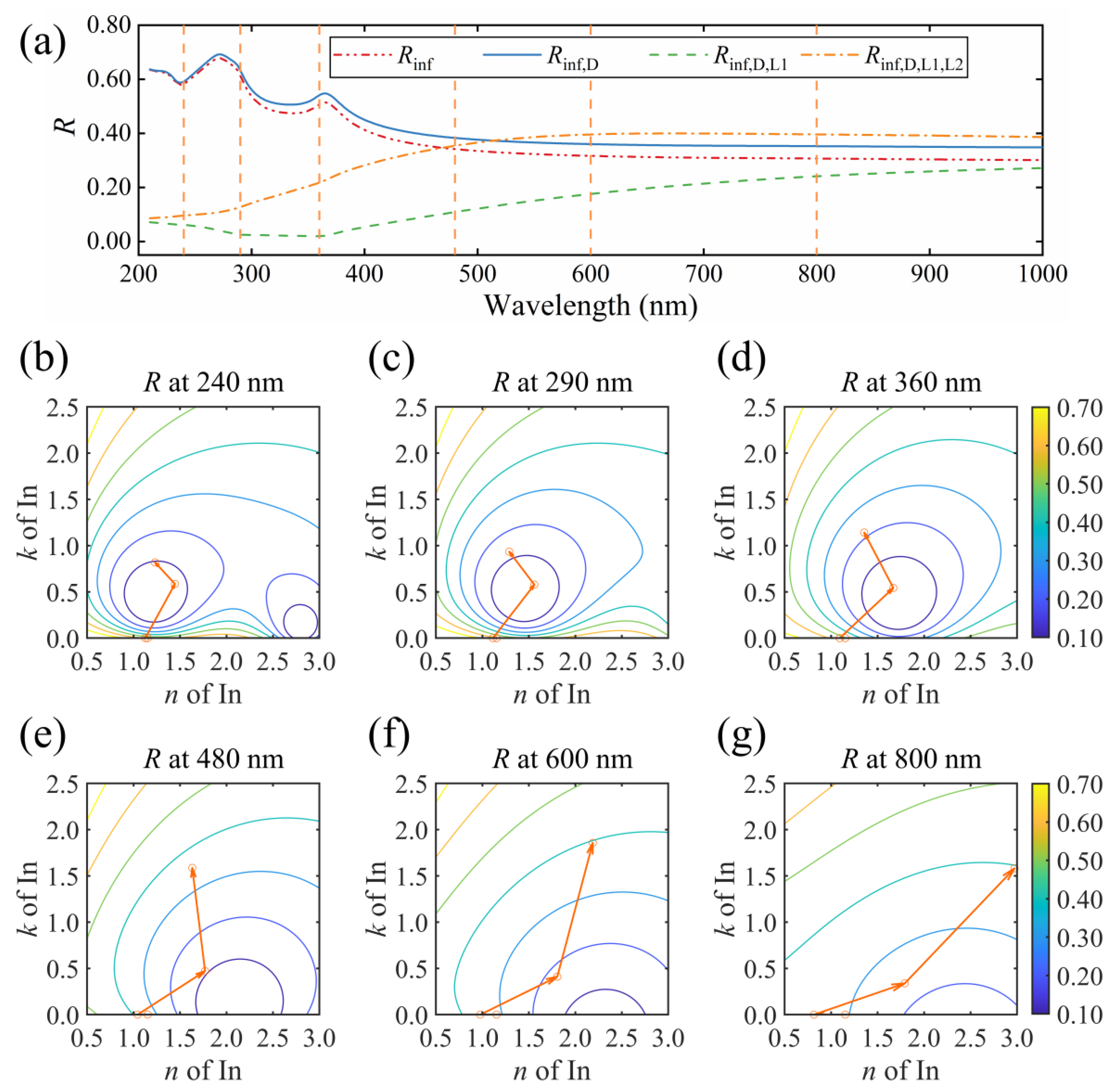


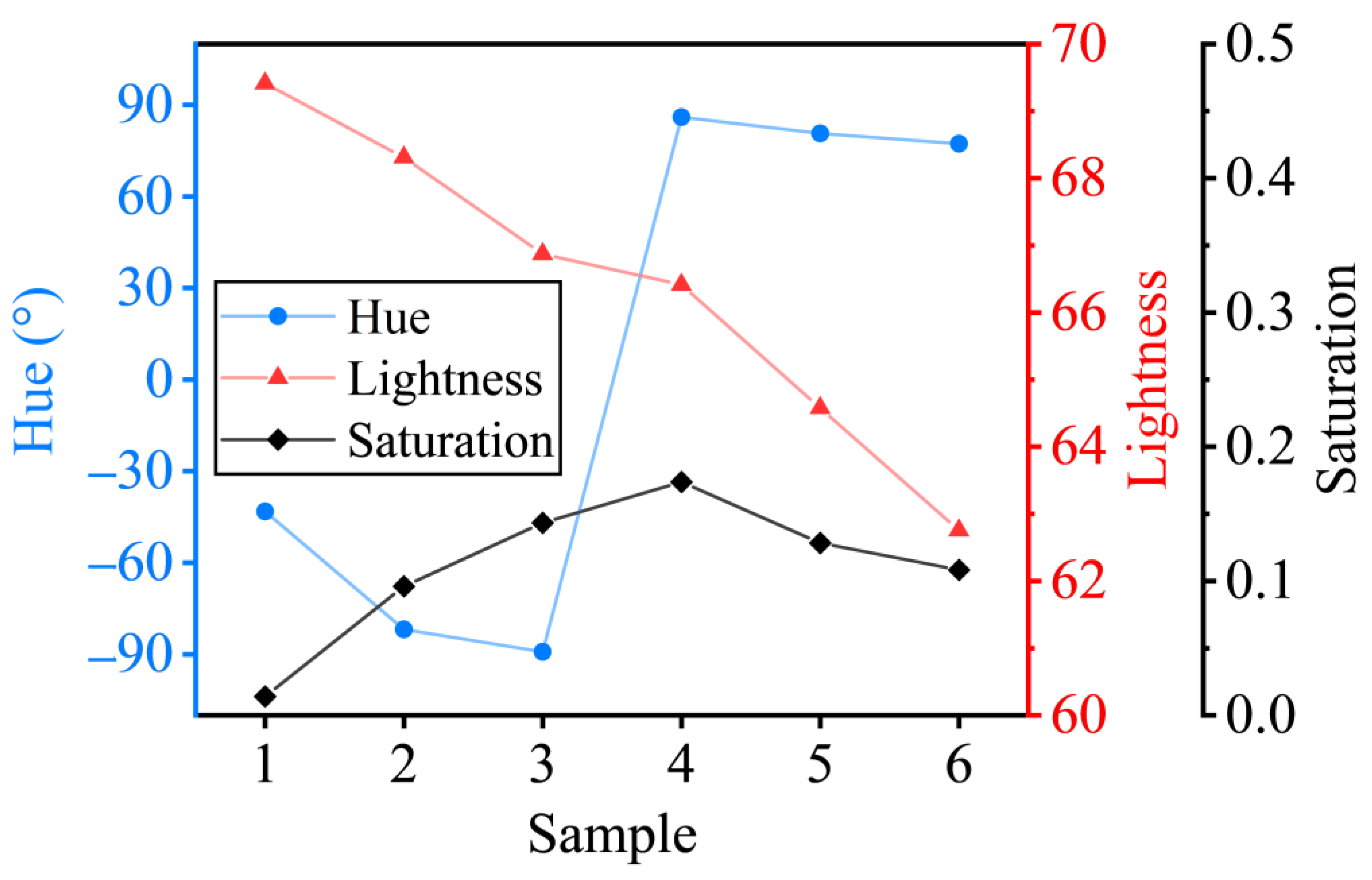
| Sample | Number of Oscillators | L* | a* | b* | Hue (°) | S |
|---|---|---|---|---|---|---|
| S1 | 1 | 59.35 | 0.08 | 3.41 | 88.69 | 0.06 |
| 1, 2 | 69.41 | −0.69 | 0.65 | −43.30 | 0.01 | |
| S2 | 1 | 46.06 | 1.87 | 16.60 | 83.59 | 0.36 |
| 1, 2 | 68.36 | −0.92 | 6.54 | −82.00 | 0.10 | |
| S3 | 1 | 31.61 | 5.65 | 15.53 | 70.00 | 0.52 |
| 1, 2 | 66.91 | −0.11 | 9.74 | −89.34 | 0.15 | |
| S4 | 1 | 35.97 | 4.70 | 18.38 | 75.67 | 0.53 |
| 1, 2 | 67.74 | −0.70 | 10.26 | −86.11 | 0.15 | |
| 1, 2, 3 | 64.32 | 0.39 | 13.72 | 88.38 | 0.21 | |
| 1, 2, 3, 4 | 66.41 | 0.82 | 11.50 | 85.90 | 0.17 | |
| S5 | 1 | 28.92 | 6.00 | 21.35 | 74.30 | 0.77 |
| 1, 2 | 61.88 | 0.24 | 10.88 | 88.72 | 0.18 | |
| 1, 2, 3 | 60.55 | 1.21 | 10.76 | 83.59 | 0.18 | |
| 1, 2, 3, 4 | 64.57 | 1.37 | 8.15 | 80.47 | 0.13 | |
| S6 | 1 | 21.71 | 9.50 | 11.06 | 49.33 | 0.67 |
| 1, 2 | 59.28 | 0.77 | 12.05 | 86.36 | 0.20 | |
| 1, 2, 3 | 58.02 | 1.96 | 8.97 | 77.69 | 0.16 | |
| 1, 2, 3, 4 | 62.75 | 1.51 | 6.61 | 77.12 | 0.11 |
Disclaimer/Publisher’s Note: The statements, opinions and data contained in all publications are solely those of the individual author(s) and contributor(s) and not of MDPI and/or the editor(s). MDPI and/or the editor(s) disclaim responsibility for any injury to people or property resulting from any ideas, methods, instructions or products referred to in the content. |
© 2023 by the authors. Licensee MDPI, Basel, Switzerland. This article is an open access article distributed under the terms and conditions of the Creative Commons Attribution (CC BY) license (https://creativecommons.org/licenses/by/4.0/).
Share and Cite
Zhang, H.-T.; He, R.; Peng, L.; Yang, Y.-T.; Sun, X.-J.; Zhang, Y.-S.; Zheng, Y.-X.; Liu, B.-J.; Zhang, R.-J.; Wang, S.-Y.; et al. Interpretation of Reflection and Colorimetry Characteristics of Indium-Particle Films by Means of Ellipsometric Modeling. Nanomaterials 2023, 13, 383. https://doi.org/10.3390/nano13030383
Zhang H-T, He R, Peng L, Yang Y-T, Sun X-J, Zhang Y-S, Zheng Y-X, Liu B-J, Zhang R-J, Wang S-Y, et al. Interpretation of Reflection and Colorimetry Characteristics of Indium-Particle Films by Means of Ellipsometric Modeling. Nanomaterials. 2023; 13(3):383. https://doi.org/10.3390/nano13030383
Chicago/Turabian StyleZhang, Hao-Tian, Rong He, Lei Peng, Yu-Ting Yang, Xiao-Jie Sun, Yu-Shan Zhang, Yu-Xiang Zheng, Bao-Jian Liu, Rong-Jun Zhang, Song-You Wang, and et al. 2023. "Interpretation of Reflection and Colorimetry Characteristics of Indium-Particle Films by Means of Ellipsometric Modeling" Nanomaterials 13, no. 3: 383. https://doi.org/10.3390/nano13030383
APA StyleZhang, H.-T., He, R., Peng, L., Yang, Y.-T., Sun, X.-J., Zhang, Y.-S., Zheng, Y.-X., Liu, B.-J., Zhang, R.-J., Wang, S.-Y., Li, J., Lee, Y.-P., & Chen, L.-Y. (2023). Interpretation of Reflection and Colorimetry Characteristics of Indium-Particle Films by Means of Ellipsometric Modeling. Nanomaterials, 13(3), 383. https://doi.org/10.3390/nano13030383









